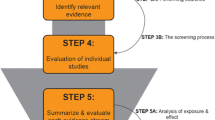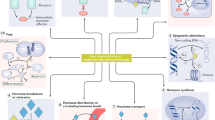Abstract
Possible harm from endocrine disrupting chemicals (EDCs) in humans is speculated based on two types of evidence; 1) increasing trends of suspected diseases in ecological studies of populations and 2) findings from traditional epidemiological studies of individuals. However, ecological findings are not regarded as direct human evidence of the relation between EDCs and disease, while the evidence among epidemiological studies of individuals is often inconsistent. Thus, a criticism is that linking EDCs and health in human is naively presumed without solid evidence. However, human studies of EDCs are methodologically complex and understanding methodological issues will help to interpret findings from existing human studies and to properly design optimal human studies. The key issues are low reliability of exposure assessment of EDCs with short half-lives, EDC mixtures, possibility of non-monotonic dose–response relationships, non-existence of an unexposed group, difficulties in measuring exposure during critical periods, and interactions with established risk factors. Furthermore, EDC mixtures may affect human health through other mechanisms than traditional endocrine disruption, for example glutathione depletion or mitochondrial dysfunction. Given this complexity, the most plausible scenario in humans is that exposure to EDC mixtures leads to increasing risk of related diseases at the ecological level, but inconsistent associations would be expected in traditional epidemiological studies. Although epidemiologists have long relied on Bradford Hill’s criteria to objectively evaluate whether associations observed in epidemiology can be interpreted as causal, there are challenges to use these criteria for EDCs, particularly concerning consistency across studies and the findings of linear dose–response relationships. At the individual level, compared to EDCs with short half-lives, epidemiological studies of EDCs with long half-lives among populations with a relatively low exposure dose range of exposure can likely produce relatively more reliable results, because the measurement of EDCs with long half-lives likely represents typical long-term exposure and populations with exposure in the low range of doses are likely to have a reference group closer to non-exposure.


Similar content being viewed by others
References
UNEP/WHO. State of the science of endocrine disrupting chemicals 2012. 2013.
Lamb JC, Boffetta P, Foster WG, et al. Critical comments on the WHO-UNEP State of the science of endocrine disrupting chemicals - 2012. Regul Toxicol Pharmacol. 2014;69:22–40.
Diamanti-Kandarakis E, Bourguignon JP, Giudice LC, et al. Endocrine-disrupting chemicals: an Endocrine Society scientific statement. Endocr Rev. 2009;30:293–342.
Barouki R, Gluckman PD, Grandjean P, et al. Developmental origins of non-communicable disease: implications for research and public health. Environ Health. 2012;11:42.
Dietrich D, von Aulock S, Marquardt HW, et al. Open letter to the European Commission: scientifically unfounded precaution drives European Commission’s recommendations on EDC regulation, while defying common sense, well-established science, and risk assessment principles. Arch Toxicol. 2013;87:1739–41.
Newbold RR. Lessons learned from perinatal exposure to diethylstilbestrol. Toxicol Appl Pharmacol. 2004;199:142–50.
Rappaport SM, Smith MT. Epidemiology. Environment and disease risks. Science. 2010;330:460–1.
Li Z, Romanoff LC, Lewin MD, et al. Variability of urinary concentrations of polycyclic aromatic hydrocarbon metabolite in general population and comparison of spot, first-morning, and 24-h void sampling. J Expo Sci Environ Epidemiol. 2010;20:526–35.
Preau Jr JL, Wong LY, Silva MJ, et al. Variability over 1 week in the urinary concentrations of metabolites of diethyl phthalate and di(2-ethylhexyl) phthalate among eight adults: an observational study. Environ Health Perspect. 2010;118:1748–54.
Ye X, Wong LY, Bishop AM, et al. Variability of urinary concentrations of bisphenol A in spot samples, first morning voids, and 24-hour collections. Environ Health Perspect. 2011;119:983–8.
Kissel JC, Curl CL, Kedan G, et al. Comparison of organophosphorus pesticide metabolite levels in single and multiple daily urine samples collected from preschool children in Washington State. J Expo Anal Environ Epidemiol. 2005;15:164–71.
Scher DP, Alexander BH, Adgate JL, et al. Agreement of pesticide biomarkers between morning void and 24-h urine samples from farmers and their children. J Expo Sci Environ Epidemiol. 2007;17:350–7.
Vrijheid M, Slama R, Robinson O, et al. The human early-life exposome (HELIX): project rationale and design. Environ Health Perspect. 2014;122:535–44.
Ning M, Lo EH. Opportunities and challenges in omics. Transl Stroke Res. 2010;1:233–7.
Silva E, Rajapakse N, Kortenkamp A. Something from “nothing”--eight weak estrogenic chemicals combined at concentrations below NOECs produce significant mixture effects. Environ Sci Technol. 2002;36:1751–6.
Kortenkamp A. Ten years of mixing cocktails: a review of combination effects of endocrine-disrupting chemicals. Environ Health Perspect. 2007;115 Suppl 1:98–105.
Kretschmer XC, Baldwin WS. CAR and PXR: xenosensors of endocrine disrupters? Chem Biol Interact. 2005;155:111–28.
Kortenkamp A. Low dose mixture effects of endocrine disrupters: implications for risk assessment and epidemiology. Int J Androl. 2008;31:233–40.
Lioy PJ, Rappaport SM. Exposure science and the exposome: an opportunity for coherence in the environmental health sciences. Environ Health Perspect. 2011;119:A466–7.
Taylor KW, Novak RF, Anderson HA, et al. Evaluation of the association between persistent organic pollutants (POPs) and diabetes in epidemiological studies: a national toxicology program workshop review. Environ Health Perspect. 2013;121:774–83.
Wu H, Bertrand KA, Choi AL, et al. Persistent organic pollutants and type 2 diabetes: a prospective analysis in the nurses’ health study and meta-analysis. Environ Health Perspect. 2013;121:153–61.
Beausoleil C, Ormsby JN, Gies A, et al. Low dose effects and non-monotonic dose responses for endocrine active chemicals: science to practice workshop: workshop summary. Chemosphere. 2013;93:847–56.
Vandenberg LN, Colborn T, Hayes TB, et al. Hormones and endocrine-disrupting chemicals: low-dose effects and nonmonotonic dose responses. Endocr Rev. 2012;33:378–455.
Rhomberg LR, Goodman JE. Low-dose effects and nonmonotonic dose-responses of endocrine disrupting chemicals: has the case been made? Regul Toxicol Pharmacol. 2012;64:130–3.
Calabrese EJ. Hormetic dose–response relationships in immunology: occurrence, quantitative features of the dose response, mechanistic foundations, and clinical implications. Crit Rev Toxicol. 2005;35:89–295.
Kendig EL, Le HH, Belcher SM. Defining hormesis: evaluation of a complex concentration response phenomenon. Int J Toxicol. 2010;29:235–46.
Bergman A, Becher G, Blumberg B, et al. Manufacturing doubt about endocrine disrupter science - A rebuttal of industry-sponsored critical comments on the UNEP/WHO report State of the Science of Endocrine Disrupting Chemicals 2012. Regul Toxicol Pharmacol. 2015.
Lee DH, Porta M, Jacobs Jr DR, et al. Chlorinated persistent organic pollutants, obesity, and type 2 diabetes. Endocr Rev. 2014;35:557–601.
Golden R, Kimbrough R. Weight of evidence evaluation of potential human cancer risks from exposure to polychlorinated biphenyls: an update based on studies published since 2003. Crit Rev Toxicol. 2009;39:299–331.
Bergman A, Andersson AM, Becher G, et al. Science and policy on endocrine disrupters must not be mixed: a reply to a “common sense” intervention by toxicology journal editors. Environ Health. 2013;12:69.
Wild CP. Complementing the genome with an “exposome”: the outstanding challenge of environmental exposure measurement in molecular epidemiology. Cancer Epidemiol Biomarkers Prev. 2005;14:1847–50.
Dijk DJ, Lockley SW. Integration of human sleep-wake regulation and circadian rhythmicity. J Appl Physiol (1985). 2002;92:852–62.
Sheehan DM. No-threshold dose–response curves for nongenotoxic chemicals: findings and applications for risk assessment. Environ Res. 2006;100:93–9.
Beier EE, Inzana JA, Sheu TJ, et al. Effects of combined exposure to lead and high-fat diet on bone quality in Juvenile male mice. Environ Health Perspect. 2015;123:935–43.
Wahlang B, Falkner KC, Gregory B, et al. Polychlorinated biphenyl 153 is a diet-dependent obesogen that worsens nonalcoholic fatty liver disease in male C57BL6/J mice. J Nutr Biochem. 2013;24:1587–95.
Wei J, Lin Y, Li Y, et al. Perinatal exposure to bisphenol A at reference dose predisposes offspring to metabolic syndrome in adult rats on a high-fat diet. Endocrinology. 2011;152:3049–61.
Lim JS, Son HK, Park SK, et al. Inverse associations between long-term weight change and serum concentrations of persistent organic pollutants. Int J Obes (Lond). 2011;35:744–7.
Lind L, Lind PM. Can persistent organic pollutants and plastic-associated chemicals cause cardiovascular disease? J Intern Med. 2012;271:537–53.
Robison AK, Stancel GM. The estrogenic activity of DDT: correlation of estrogenic effect with nuclear level of estrogen receptor. Life Sci. 1982;31:2479–84.
Mills LJ, Gutjahr-Gobell RE, Haebler RA, et al. Effects of estrogenic (o, p’-DDT; octylphenol) and anti-androgenic (p, p’-DDE) chemicals on indicators of endocrine status in juvenile male summer flounder (Paralichthys dentatus). Aquat Toxicol. 2001;52:157–76.
Jansen HT, Cooke PS, Porcelli J, et al. Estrogenic and antiestrogenic actions of PCBs in the female rat: in vitro and in vivo studies. Reprod Toxicol. 1993;7:237–48.
Ma R, Sassoon DA. PCBs exert an estrogenic effect through repression of the Wnt7a signaling pathway in the female reproductive tract. Environ Health Perspect. 2006;114:898–904.
Giera S, Bansal R, Ortiz-Toro TM, et al. Individual polychlorinated biphenyl (PCB) congeners produce tissue- and gene-specific effects on thyroid hormone signaling during development. Endocrinology. 2011;152:2909–19.
Swedenborg E, Pongratz I. AhR and ARNT modulate ER signaling. Toxicology. 2010;268:132–8.
Lee DH, Jacobs Jr DR. Hormesis and public health: can glutathione depletion and mitochondrial dysfunction due to very low-dose chronic exposure to persistent organic pollutants be mitigated? J Epidemiol Community Health. 2015;69:294–300.
Zoeller RT, Bergman A, Becher G, et al. A path forward in the debate over health impacts of endocrine disrupting chemicals. Environ Health. 2015;14:118.
Author information
Authors and Affiliations
Corresponding authors
Ethics declarations
Conflict of interest
The authors declare that they have no conflict of interest.
Funding
This work was financially supported by a grant of the Korean Health Technology R&D Project, Ministry of Health & Welfare, Republic of Korea (HI13C0715) and by a National Research Foundation of Korea (NRF) grant funded by the Korea government (MEST) (No. 2013R1A2A2A01068254).
Rights and permissions
About this article
Cite this article
Lee, DH., Jacobs, D.R. Methodological issues in human studies of endocrine disrupting chemicals. Rev Endocr Metab Disord 16, 289–297 (2015). https://doi.org/10.1007/s11154-016-9340-9
Published:
Issue Date:
DOI: https://doi.org/10.1007/s11154-016-9340-9




